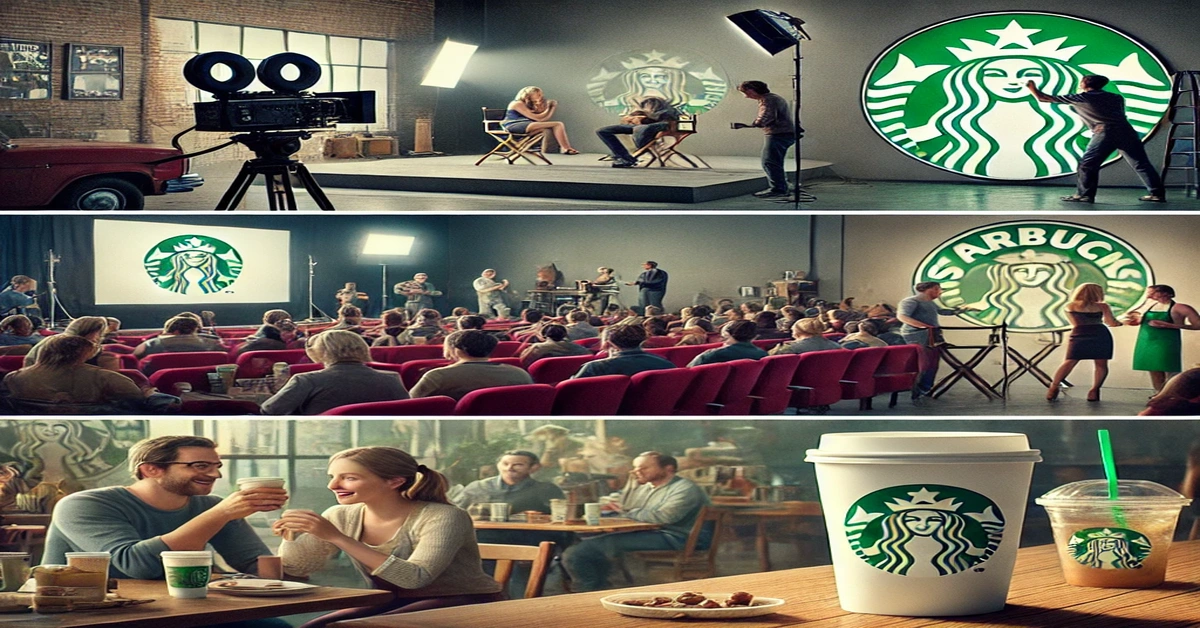In today’s entertainment-driven world product placement has become an integral part of marketing, offering brands unique exposure by integrating products seamlessly into movies, TV shows, and even social media. Starbucks, a global coffee powerhouse, has embraced product placement as a strategy to keep its iconic brand visible and relevant. From films to popular TV series, the Starbucks cup is often seen in the hands of characters, subtly blending into scenes while keeping the brand top of mind.
In this article, we’ll explore how Starbucks leverages product placement to enhance its brand presence, analyze notable examples of Starbucks product placements, and examine the impact and effectiveness of this marketing approach.
Why Starbucks Uses Product Placement?
Product placement provides Starbucks with a unique way to connect with audiences, creating a brand presence without the direct pressure of traditional advertising. Here’s why Starbucks invests in this marketing approach:
1. Enhanced Brand Visibility
By placing Starbucks products in popular media, the brand can reach audiences in an environment where they’re already engaged. Viewers see the brand in relatable, everyday contexts, which makes it feel like a natural part of the story rather than a direct advertisement.
2. Emotional Connection with Audiences
Starbucks product placements often appear in scenes that are memorable, emotional, or central to character development, associating the brand with moments that resonate with viewers. This emotional connection can be more effective than standard ads, as it aligns the brand with the story’s mood and feel.
3. Increased Credibility and Authenticity
When viewers see their favorite characters enjoying a Starbucks coffee, it can feel genuine and relatable. This association builds a perception of Starbucks as a brand that fits seamlessly into real-life scenarios, enhancing its credibility and appeal.
Types of Product Placement Used by Starbucks
Starbucks employs several types of product placement techniques to increase brand exposure:
1. Visual Placement
Visual placement involves featuring Starbucks products or branding within a scene without directly drawing attention to them. This type of placement is often subtle, with Starbucks cups or signage visible in the background.
2. Verbal Mention
Sometimes, characters in movies or TV shows mention Starbucks by name, which can reinforce brand awareness and recognition. Verbal mentions may not involve a visual element, but they still create an auditory association with the brand.
3. Usage Placement
In usage placement, characters are shown drinking or purchasing Starbucks products as part of their regular activities. This type of placement conveys that Starbucks is a natural choice for daily routines and social interactions.
Notable Examples of Starbucks Product Placement
Starbucks has appeared in various popular media, from movies to TV shows, helping reinforce its image as an everyday go-to brand. Here are some memorable examples:
1. “You’ve Got Mail”
In the romantic comedy “You’ve Got Mail,” Starbucks plays a subtle yet notable role in establishing the setting. Tom Hanks’ character is seen ordering a Starbucks coffee, a nod to the brand’s ubiquity in urban environments. The placement reflects the central theme of city life and modern communication, aligning Starbucks with an urban, cosmopolitan lifestyle.
2. “Sex and the City”
The TV series “Sex and the City” prominently features Starbucks, with characters often grabbing coffee cups during conversations or while walking through New York City. The recurring appearance of Starbucks cups fits seamlessly into the show’s depiction of bustling city life and aligns with the show’s fashionable, trendy vibe.
3. “The Devil Wears Prada”
In “The Devil Wears Prada,” Starbucks becomes a recurring theme as the main character, played by Anne Hathaway, frequently picks up coffee for her demanding boss. Starbucks’ presence here isn’t just about coffee; it symbolizes the fast-paced, high-stakes world of fashion and media. The placement highlights Starbucks as the fuel for productivity in a high-energy work environment.
4. “House of Cards”
In the political drama “House of Cards,” Kevin Spacey’s character frequently visits Starbucks locations, using them as casual meeting spots or for quick coffee breaks. This placement aligns Starbucks with power, strategy, and ambition, appealing to viewers who associate Starbucks with their own professional lives.
5. “Modern Family”
In “Modern Family,” Starbucks coffee cups occasionally make appearances, especially during family gatherings or casual scenes. The presence of Starbucks subtly reinforces the idea that it’s a familiar, family-friendly brand that fits into a variety of life’s moments, from casual chats to family events.
How Product Placement Aligns with Starbucks’ Brand Image
Starbucks has carefully positioned itself as more than just a coffee brand—it’s a lifestyle brand associated with comfort, community, and modernity. Through product placement, Starbucks reinforces this identity in ways that traditional ads might not achieve. Here’s how Starbucks product placement aligns with its brand values:
1. Convenience and Accessibility
By appearing in everyday settings within movies and TV shows, Starbucks highlights its accessibility and ubiquity. Viewers see it as a convenient option, readily available in various situations, reinforcing its position as a go-to choice for coffee lovers.
2. Association with Popular Culture
Starbucks product placements often appear in shows and movies that shape or reflect popular culture. By associating itself with these cultural touchstones, Starbucks reinforces its relevance and appeals to audiences who consider it part of their daily life.
3. Community and Social Interaction
Many product placements show Starbucks as a meeting place, reinforcing the idea of coffee as a social connector. These scenes align with Starbucks’ brand image as a welcoming space where people can come together to connect, work, or relax.
The Impact of Starbucks Product Placement on Consumer Behavior
Product placement can have a subtle yet powerful influence on consumer behavior. For Starbucks, these placements help drive brand loyalty and influence purchasing decisions. Here’s how product placement impacts consumer perception and behavior:
1. Increased Brand Recall
When viewers see Starbucks in various shows and films, it reinforces brand recognition and recall. This repeated exposure makes it more likely that consumers will think of Starbucks when they want coffee, associating it with everyday life.
2. Influence on Purchasing Decisions
Seeing Starbucks cups in the hands of beloved characters can influence viewers to choose Starbucks over competitors. This form of influence is especially effective because it’s subtle and embedded in relatable scenarios, making the choice to visit Starbucks feel more organic.
3. Brand Loyalty
By associating Starbucks with emotional scenes and popular characters, product placement fosters a sense of loyalty among viewers. People feel a personal connection with the brand, as if it’s part of their favorite moments, increasing their likelihood to remain loyal to Starbucks.
How Starbucks Plans Its Product Placement Strategy
Product placement isn’t accidental—it’s a carefully planned strategy. Starbucks works with production companies and marketers to place its products in shows and movies that align with its target audience and brand values. Here’s how Starbucks approaches its product placement strategy:
1. Selecting Relevant Media
Starbucks carefully selects media that resonate with its brand image, such as urban dramas, romantic comedies, and family-friendly shows. This choice ensures that Starbucks is seen in scenarios where it feels natural and aligns with the company’s core values.
2. Crafting a Subtle Presence
Starbucks product placement is rarely intrusive. Instead, the brand often appears as a part of the background or as an accessory to a character’s routine. This subtlety reinforces Starbucks’ image as a natural part of everyday life without overwhelming the scene.
3. Targeting Key Demographics
By appearing in media that resonates with its primary demographic—such as young professionals, urban dwellers, and coffee enthusiasts—Starbucks ensures that its product placements are relevant and relatable to its target audience.
Challenges and Criticisms of Product Placement
While product placement can be highly effective, it’s not without its challenges. Some critics argue that excessive product placement can detract from a viewer’s experience, while others raise concerns about the blurred line between entertainment and advertising. Here’s a look at some potential challenges for Starbucks:
1. Risk of Overexposure
Too many appearances in a single show or movie can feel excessive and detract from the storytelling. Starbucks must strike a balance to ensure its presence feels authentic rather than overly commercial.
2. Viewer Discomfort
Some viewers are put off by obvious product placements, feeling that it detracts from the story. Starbucks aims to keep its product placements subtle to avoid this potential discomfort among viewers.
3. Authenticity Concerns
If a product placement doesn’t feel natural to the scene, it can feel forced and may even damage the brand’s reputation. Starbucks works to avoid placements that feel out of place, focusing on natural integration.
Conclusion
Product placement is a subtle yet powerful marketing tool, allowing Starbucks to remain visible, relatable, and relevant. By integrating seamlessly into popular media, Starbucks keeps its brand top of mind for millions of viewers worldwide, reinforcing its position as a familiar and accessible part of modern life. Whether in a political drama, a romantic comedy, or a family sitcom, Starbucks product placement connects the brand with memorable characters and moments, building emotional resonance that drives brand loyalty.
FAQs
What is product placement for Starbucks?
Product placement for Starbucks is the strategic integration of its brand in movies, TV shows, and media to enhance visibility.
Why does Starbucks use product placement?
Starbucks uses product placement to reinforce its brand as an everyday choice, connecting with audiences in a natural, subtle way.
What are some examples of Starbucks product placements?
Examples include “Sex and the City,” “The Devil Wears Prada,” and “House of Cards,” where Starbucks cups appear frequently.
Does Starbucks pay for product placements?
Yes, Starbucks typically collaborates with production companies to include its products in media, although specifics may vary.
How does product placement impact Starbucks’ brand image?
Product placement reinforces Starbucks’ image as accessible, reliable, and culturally relevant, aligning with modern lifestyles.
What is visual placement in product placement?
Visual placement is when a product appears in the background or is visible without being directly mentioned or used by characters.
Is product placement effective for Starbucks?
Yes, product placement has proven effective in keeping Starbucks top of mind for viewers, fostering brand loyalty and recognition.
How does Starbucks choose which shows or movies for placement?
Starbucks selects media that aligns with its brand image and target demographic to ensure a natural fit.







